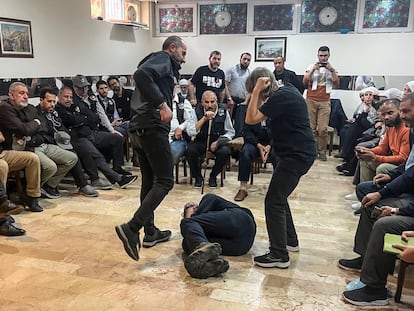Israel-Gaza, anatomy of a border at war: ‘We can’t live like this forever. They can’t live like this forever either’
The 42 miles of Israeli highway that surround the Strip pass between the horror of the Hamas massacre and the offensive in the Palestinian enclave, and the hope of those who are trying to recover their lives

Horror and hope go hand in hand along the 69 kilometers (42.8 miles) of highway that surround Gaza through Israeli territory. The route starts from the north, near the Erez crossing, and descends towards Kerem Shalom, the point where Israel, Egypt, and Rafah — which the Israeli army has threatened to invade imminently — meet. Along the way, the bloody milestones of the attacks by Hamas on October 7, when some 1,200 people were killed and 250 were taken hostage, according to official figures. And on the other side of the border, the ravages of the war in Gaza. U.S. Secretary of State Antony Blinken is scheduled to visit the area for the first time this Wednesday on his seventh trip to Israel since the war began.
It is the same territory where some citizens are attempting to resume normal life. It is not an easy task: just a few meters away, on the other side of the demarcation fence, the Israeli military has killed over 34,500 Gazans in the last six months, and the occupation and attacks continue. This journey takes place on a border that is currently witnessing a full-scale war, but at the same time it is also a frontier that has hardly known peace since the birth of the State of Israel 75 years ago.
“These communities will be rebuilt and the area will flourish again. People are going to come back to live here. And the children will return to play on every street corner,” says an optimistic Martin Filkenstein, a 45-year-old farmer from Kibbutz Nir Oz, where a quarter of his 400 neighbors were killed or kidnapped in the Hamas attacks. But life remains on hold today, except for the handful of workers who, like Filkenstein, come every day from the towns far from the border where they live temporarily. There is no timetable for the return of the population, nor does he know how many will want to come back. For the time being, he says, the trauma of what he has experienced continues, although he, personally, is not afraid.
Until October 7, Erez was the main link between Gaza and Israel, mainly because of some 20,000 Palestinian workers from the enclave who were employed in Israeli territory. Amid international pressure, Israel announced a month ago that it would allow the arrival of humanitarian aid through this crossing to the north of the Strip, the area hardest hit by famine, one of the weapons being used against the 2.3 million Gazans in the conflict. Erez remains closed, but in recent weeks a few more trucks have been allowed into the northern part of the Strip.
In the early hours of October 7, Erez was one of the places attacked by Hamas militiamen to gain access to Israel. A few minutes away, the village of Kibbutz Yad Mordechai, which was the site of an intense battle during Israel’s 1948 war of independence, again became the scene of bloodshed. Another Hamas target was Sderot, located on the northeastern edge of Gaza a few hundred meters from the border, and the Israeli town traditionally hardest hit by Palestinian rockets. It is the only place on the route where, compared to previous visits in recent months, normality has been gradually returning.
Recovering life
Gone are the days immediately after the attack — in which 70 residents were killed — when barely 10% of Sderot’s 30,000 inhabitants remained. The trickle of returnees, with schools now reopened, means that today it is not easy to find a parking space in the commercial areas. “We are getting life back,” says Shaili Elkayam, 21, an employee at a children’s clothing store, as she smokes a cigarette. The level of clientele is around 50%, she estimates. Nevertheless, the young woman says that the window panes still shake from time to time from the explosions, which frighten her dog, she adds with a grimace.
Road 232, which runs through Sderot, descends in a southerly direction parallel to the Gaza perimeter. As the main axis of the carnage, it became the road of death. It bears little resemblance now to the days after the attacks when hundreds of burned or bullet-riddled cars were removed while a bulldozer swept away, as though they were puppets, the remains of the jihadists who had died in clashes with the Israeli army at the entrance to Kibbutz Beeri, as witnessed by this special envoy.
The Beeri crossing is the prelude to the worst-case scenario of the Hamas carnage. A grove of trees on the right side of the road marks the spot where the Nova festival was being held that fateful Saturday, at which several thousand young people were dancing carefree at dawn. Up to 360 of them died in a merciless assault that lasted hours.
Today, the site has become a kind of open-air shrine where people from all over Israel and overseas make pilgrimages. Dozens of people arriving in two buses, some with audio guides around their necks, wander among the photos, banners, candles, makeshift altars, inscriptions, and personal items — even car keys — placed in memory of the victims.
Isaac Markman, 58, a Brazilian-born Jew living in Vancouver, Canada, keeps thinking of his college-age daughters, Amanda, 24, and Giovanna, 22. “I see them both in the faces of all these young people,” he says, standing in front of the photos with several Israeli flags flying in the air. “And I also see them in all these young military personnel,” he adds as he passes a girl wearing an army uniform. Markman and his wife Flavia, 53, have visited several of the sites marked by last October’s carnage. “We have come as a sign of mourning,” says Flavia, unable to hold back tears. They are accompanied by her brother-in-law, Menashe Zugman, and his wife.
Zugman, of Argentine origin and a resident of one of the Jewish settlements in the occupied West Bank, has been a tour guide for years at Holocaust memorial sites, especially in Poland. “We can’t compare this with the Shoah” — the Holocaust, in which between five and six million Jews died — he admits, although “October 7 is closer; it’s the present.” Despite everything, Zugman leans on the fact that 85% of those attending the Nova festival survived. “Today it is safer than on October 7. I look to the future with faith,” he concludes. In the background, the Israeli artillery booms every now and then, firing towards neighboring Gaza, a clear reminder that the war is only about five kilometers (three miles) away.
That doesn’t stop some people in the area from going back to their daily chores. Four Thai workers toil in a mango field outside Kibbutz Nir Yitzhak. They have been in Israel for several years but none were victims of the Hamas attacks, in which several compatriots were killed and others were kidnapped. When asked why they have not left despite the conflict, Kadi, one of the workers, responds by rubbing his fingertips together, gesturing that they need the money.
Agriculture is the major economic engine of the communities that are springing up on Gaza’s outer perimeter. Large expanses of greenhouses dominate the landscape, although many are still without crops. In fact, the war has plunged the sector into the worst crisis in its history. In Kibbutz Nir Oz, losses amount to “several million euros,” says Filkenstein, a member of the cooperative that manages the fields on which up to 80% of the community’s economy depends, some located just 700 meters from the Gaza border fence.
Driven by the need to minimize losses, he and a dozen other residents were back at work a few days after the attacks. More than three-quarters of their income comes from the potato crop, which is planted in October and November, so the current harvest has been lost, says Filkenstein, a Jew who arrived from Argentina 25 years ago and escaped the Hamas assault after hiding with his wife and three children for 12 hours.
The asphalt, corrugated by the caterpillar tracks of tanks and armored vehicles, is being renewed on some sections of the road. Further south, a column of smoke rises into the sky near the Palestinian town of Rafah, on the border with Egypt. Meanwhile, on the Israeli side, a tractor and a straw-baling machine are working in the background. Several white balloons fixed to the ground with ropes serve the Israeli military as observation points over the Palestinian enclave, where access is forbidden to reporters.
An armed officer prevents entry into Kibbutz Kerem Shalom, bordering the Strip. Further down, where Israel, Gaza, and Egypt meet, only the crossing facilities into Palestinian territory remain. The road is guarded by a police checkpoint from which, in the background, one can see the long line of trucks carrying humanitarian aid at the border, waiting to be inspected by Israeli agents before they are given the green light to pass to the Gazan side.
“We can’t live like this forever. They can’t live like this forever either,” sighs Filkenstein, who also considers the people of Gaza victims of Hamas radicalism. Is it possible to achieve peace on this border? “I think it’s difficult,” concludes the Argentina-born farmer.
Sign up for our weekly newsletter to get more English-language news coverage from EL PAÍS USA Edition
Tu suscripción se está usando en otro dispositivo
¿Quieres añadir otro usuario a tu suscripción?
Si continúas leyendo en este dispositivo, no se podrá leer en el otro.
FlechaTu suscripción se está usando en otro dispositivo y solo puedes acceder a EL PAÍS desde un dispositivo a la vez.
Si quieres compartir tu cuenta, cambia tu suscripción a la modalidad Premium, así podrás añadir otro usuario. Cada uno accederá con su propia cuenta de email, lo que os permitirá personalizar vuestra experiencia en EL PAÍS.
¿Tienes una suscripción de empresa? Accede aquí para contratar más cuentas.
En el caso de no saber quién está usando tu cuenta, te recomendamos cambiar tu contraseña aquí.
Si decides continuar compartiendo tu cuenta, este mensaje se mostrará en tu dispositivo y en el de la otra persona que está usando tu cuenta de forma indefinida, afectando a tu experiencia de lectura. Puedes consultar aquí los términos y condiciones de la suscripción digital.
More information
Archived In
Últimas noticias
Most viewed
- Sinaloa Cartel war is taking its toll on Los Chapitos
- Oona Chaplin: ‘I told James Cameron that I was living in a treehouse and starting a permaculture project with a friend’
- Reinhard Genzel, Nobel laureate in physics: ‘One-minute videos will never give you the truth’
- Why the price of coffee has skyrocketed: from Brazilian plantations to specialty coffee houses
- Silver prices are going crazy: This is what’s fueling the rally










































